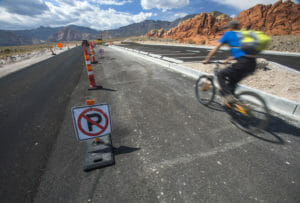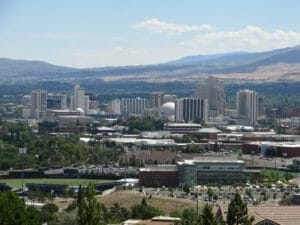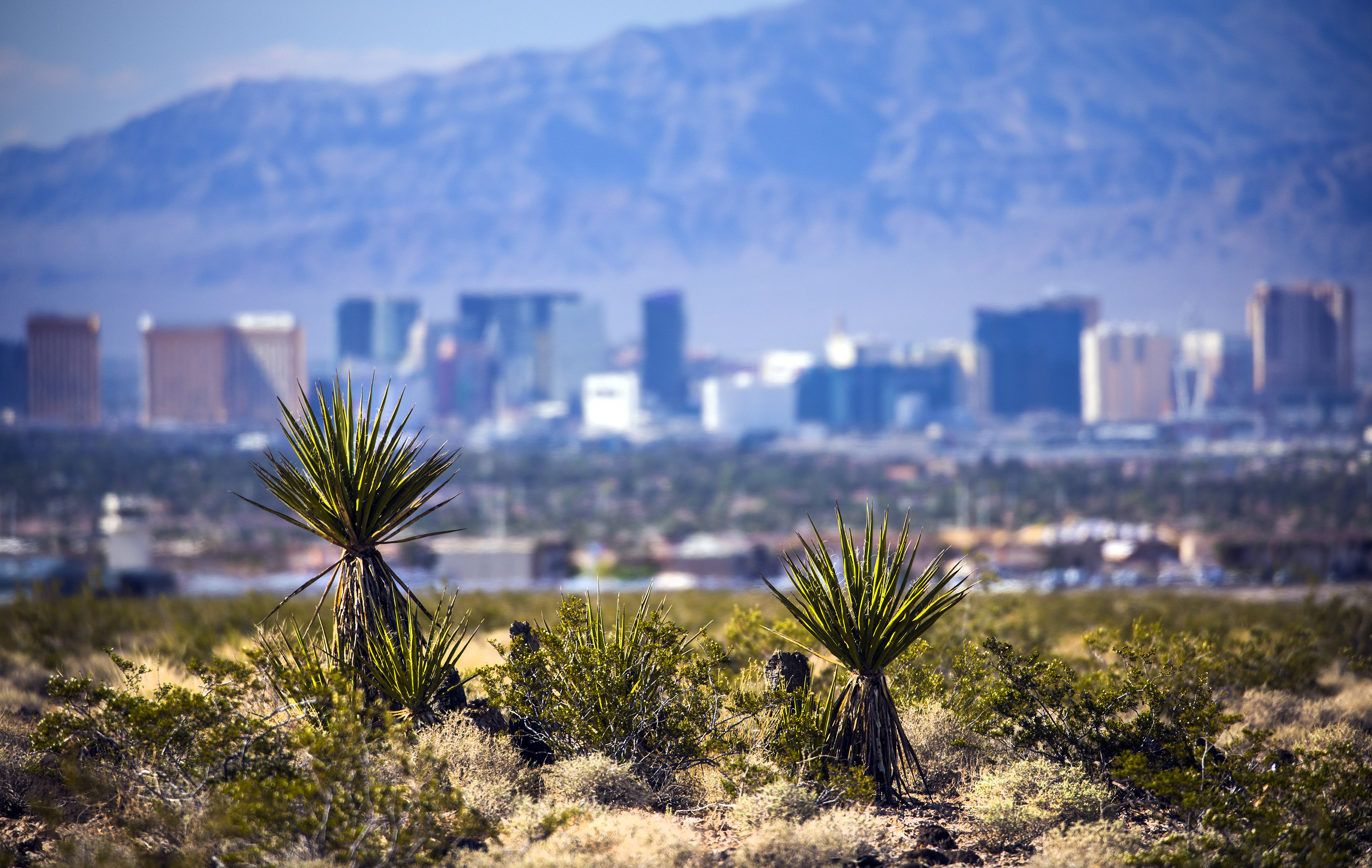Urban counties contend with growth, development and environmental concerns
The pitches are the same: There is a housing crisis.
That's the argument frequently brandished by homebuilders to try to get massive development projects approved by local governments in Nevada's urban areas.
But with real estate development pushing up against the boundaries of Reno and Las Vegas, elected officials have been forced to contend with the tug-of-war between advocates of the natural environment and the need to keep up with population growth.
The regions, though different in topography, often face similar issues.
Both are weighing federal legislation that would allow the state’s two urban areas to potentially expand out onto public land. And as developable land becomes more scarce and increasingly close to wilderness, elected officials in Reno and Las Vegas are being forced to weigh environmental constraints on growth in deciding whether to approve new developments.
“We want to prioritize growth in urbanized areas and minimize expansion in other areas,” said Ron Krater, the lead consultant for a decades-long effort to build a master-planned community near Red Rock National Conservation Area in Las Vegas. “Within that conversation, you’re always going to find a dynamic between local governments wanting economic growth — and their need to grow the development footprint — with the need to be environmentally sensitive.”
That statement might come as a surprise to many conservationists.

For years, residents and environmentalists have pushed back against the effort to build in the hills near Red Rock, which draws in millions of climbers, hikers and campers each year. They believe development would destroy the canyon’s character with thousands of new homes.
Krater sees it differently. He said the Red Rock project is environmentally responsible because the homes would replace an old gypsum mine, land he called completely “obliterated.” In his view, the debate over Red Rock became a political football during a heated election year.
In the past, Clark County officials have tended to agree with him, but the County Commission has appeared to take a tougher stance on the issue in the wake of an election where it was featured in a primary attack ad against Clark County Commission Chair and Gov.-elect Steve Sisolak.
Sisolak, who voted to approve the concept plan, came out strongly against a request from the developer to waive a requirement on obtaining a right-of-way a few weeks before the election.
“Our project is important in the sense that it has become political,” Krater said during an interview in November after the election. “I understand that. But the political conversations have moved away from the science and they have moved away from the professionals."
His view represents that of many developers. Several have argued that their projects — in floodplains and butting up against faraway wilderness — are not only “environmentally sound” but necessary to solve the housing crisis. Yet over the past year, developers have had a mixed record convincing elected officials of that, often amid vocal pushback from constituents.
"I think there is an uncoordinated shift in local government toward leaders who are concerned about conservation issues and growth generally,” said Justin Jones, a newly elected Clark County commissioner and an attorney who led a lawsuit over the Red Rock project.
Nowhere is this more acute than in Reno, where economic growth has fueled a housing crunch.
“What we’re seeing is that elected officials are starting to understand how complex these competing values are,” said Reno Councilman David Bobzien. “On the one hand, there is a desire to see more compact infill development as a way to cut down on auto emissions... And yet you have projects that are arguably closer into the core that then bump up against floodplain values and even sometimes scenic values. All these factors start to become complicated.”

In a 6-1 vote last month, the Reno City Council turned down a 4,700-unit development to construct homes in the metro’s last natural floodplain. The developer for the project, known as Daybreak, argued that mitigation measures to offset flood risk would leave the land more protected.
“We’re leaving it with more of a resource at the end of the day than exists out there currently,” said Andy Durling, a consultant with Wood Rodgers, an engineering firm working on Daybreak.
After lengthy public comment, the City Council voted down the project because Reno’s master plan discourages development in floodplains and because the plans relied on hydrologic assumptions that had not been updated by flood management planners for decades.
“I’ve seen them make really good decisions,” Brian Beffort, Toiyabe Chapter Director for the Sierra Club, said of the Reno City Council’s overall response to growth. “I’ve seen them make really bad decisions… Opposing Daybreak was an example of a wise move.”
Beffort said an example of a bad decision was the approval of StoneGate, a development project to bring about 5,000 homes to the northern edges of Reno in the next two decades.
Councilwoman Jenny Brekhus, the lone vote against the StoneGate development, has appealed some StoneGate approvals, an action that is scheduled to be heard at a City Council on Jan. 9.
“It is textbook remarkably premature leapfrog development,” Brekhus said. “It is so far out [of the city] that I think some of the reviewing agencies didn’t even have the models to evaluate it.”
Brekhus added that the faraway nature of the development could create more car pollution.
“For a region teetering on compliance with the Clean Air Act, it just boggles the mind,” she said.
But the Reno City Council is not the only one with a say in where and what kind of development occurs in Truckee Meadows. The county, which stretches from Reno to the Nevada border with Oregon, is also a key player in how land is developed. Beffort said the Sierra Club is concerned county governments in Reno and in Las Vegas have been promoting too much sprawl.
“I think [the county commissions] are paying dangerously little attention to the environmental impacts of growth,” he said. “And their inattention will come back to bite us.”
For many politicians, Beffort argued that the state’s landscape can be “deceptive.”
“If you look out, it looks like there is lots of space,” he added. “It looks like there is lots of room to grow. But if our only focus is expanding our footprint and growing out, we’re making our communities less healthy and less enjoyable in many ways.”

Most politicians — and many homebuilders — have said they support infill development but that pushing infill development alone could have some unintended consequences. Infill projects tend to be more expensive and less attractive to homebuilders, developers argue, because of more complex zoning rules, existing land disturbance and higher land prices.
But if Las Vegas and Reno want to grow outward, they are often blocked by the fact that most of the parcels on the edges of town are managed by the federal government as public land.
“Growth in Nevada in any of the cities often run up against public land,” said Shaaron Netherton, executive director of Friends of Nevada Wilderness, which works on public lands legislation.
Earlier this year, Clark County approved a resolution requesting the congressional delegation to introduce a bill that would clear about 38,000 acres of public land for development, mostly along the I-15 corridor and potentially extending Las Vegas’ boundary toward the California border.
For months, Washoe County officials have been working on a similar plan.
Their proposed legislation would allow federal land managers to auction off about 120,000 acres of public land to developers within a defined boundary. The county has asked that the proceeds of selling federal public land go back to Nevada, but that might be a difficult ask for other members of Congress from other states who would have to approve the legislation.
“I know that the changes in the election will have an impact, but I don’t know how big of an impact that will be,” said Marsha Berkbigler, the chair of the Washoe County Commission.
Both counties had wanted legislation in Congress by the end of the year, but the counties faced pushback from environmental groups. In Clark County, many groups stayed neutral on the bill, but others, including the Sierra Club and Center for Biological Diversity, opposed the plan, arguing that it could harm protections for the threatened desert tortoise and create more sprawl.
In Washoe County, environmentalists were concerned the proposal could strip wilderness-style protections for about 250,000 acres of land that support an outdoor recreation economy.
“We’re still trying to work [with conservation groups] to find out what that happy medium is,” Jamie Rodriguez, the county’s government affairs manager who is working on the bill. “We want a level of consensus with all of the entities so we aren’t leaving anyone out.”
The Washoe County proposal comes as the region undergoes a more comprehensive planning effort to determine what form the Truckee Meadows area should take as planners prepare for more than 100,000 new residents over the next two decades. Jeremy Smith, a GIS Coordinator working on the planning effort for the Truckee Meadows Regional Planning Agency, said that the community, through that process, has an opportunity to decide how the region should grow.
“We’re not necessarily looking to limit anything, but we’re looking to manage it in a reasonable fashion,” Smith said. “That’s the conversation that’s going to continue.”
The agency has come up with four potential growth patterns and is asking residents to weigh in on which option they prefer. At City Council and County Commission meetings, dozens of residents come out each week to comment on specific developments. But Bobzien said those constituents should also engage more closely with the high-level regional planning process.
“Those planning decisions are what’s really going to have the most impact on what the region looks like,” Bobzien said. “In so many ways, the battles and fights we are having right now, whether it’s StoneGate or Daybreak, are attached to decisions made over a decade ago.”
